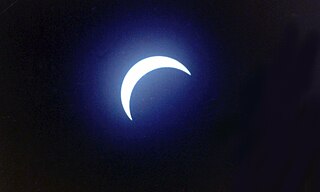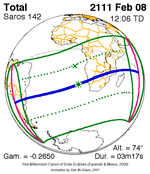Solar eclipse of November 22, 1984
| Solar eclipse of November 22, 1984 | |
|---|---|
 Partial from Gisborne, New Zealand | |
 Map | |
| Type of eclipse | |
| Nature | Total |
| Gamma | -0.3132 |
| Magnitude | 1.0237 |
| Maximum eclipse | |
| Duration | 120 sec (2 m 0 s) |
| Coordinates | 37°48′S 173°36′W / 37.8°S 173.6°W |
| Max. width of band | 85 km (53 mi) |
| Times (UTC) | |
| Greatest eclipse | 22:54:17 |
| References | |
| Saros | 142 (21 of 72) |
| Catalog # (SE5000) | 9475 |
A total solar eclipse occurred on November 22, 1984. A solar eclipse occurs when the Moon passes between Earth and the Sun, thereby totally or partly obscuring the image of the Sun for a viewer on Earth. A total solar eclipse occurs when the Moon's apparent diameter is larger than the Sun's, blocking all direct sunlight, turning day into darkness. Totality occurs in a narrow path across Earth's surface, with the partial solar eclipse visible over a surrounding region thousands of kilometres wide. Totality was visible in Indonesia, Papua New Guinea and southern Pacific Ocean. West of the International Date Line the eclipse took place on November 23, including all land in the path of totality. Occurring only 2.1 days after perigee (Perigee on November 20, 1984), the Moon's apparent diameter was fairly larger.
Related eclipses[]
Eclipses of 1984[]
- A penumbral lunar eclipse on May 15.
- An annular solar eclipse on May 30.
- A penumbral lunar eclipse on June 13.
- A penumbral lunar eclipse on November 8.
- A total solar eclipse on November 22.
Solar eclipses of 1982–1985[]
This eclipse is a member of a semester series. An eclipse in a semester series of solar eclipses repeats approximately every 177 days and 4 hours (a semester) at alternating nodes of the Moon's orbit.[1]
Note: Partial solar eclipses on January 25, 1982 and July 20, 1982 occur in the previous lunar year eclipse set.
| showSolar eclipse series sets from 1982–1985 |
|---|
Saros 142[]
It is a part of Saros cycle 142, repeating every 18 years, 11 days, containing 72 events. The series started with partial solar eclipse on April 17, 1624. It contains one hybrid eclipse on July 14, 1768, and total eclipses from July 25, 1786 through October 29, 2543. The series ends at member 72 as a partial eclipse on June 5, 2904. The longest duration of totality will be 6 minutes, 34 seconds on May 28, 2291. All eclipses in this series occurs at the Moon’s descending node.[2]
| showSeries members 17–41 occur between 1901 and 2359 |
|---|
Inex series[]
This eclipse is a part of the long period inex cycle, repeating at alternating nodes, every 358 synodic months (≈ 10,571.95 days, or 29 years minus 20 days). Their appearance and longitude are irregular due to a lack of synchronization with the anomalistic month (period of perigee). However, groupings of 3 inex cycles (≈ 87 years minus 2 months) comes close (≈ 1,151.02 anomalistic months), so eclipses are similar in these groupings.
| showInex series members between 1901 and 2100: |
|---|
Metonic series[]
The metonic series repeats eclipses every 19 years (6939.69 days), lasting about 5 cycles. Eclipses occur in nearly the same calendar date. In addition, the octon subseries repeats 1/5 of that or every 3.8 years (1387.94 days). All eclipses in this table occur at the Moon's descending node.
| show22 eclipse events between September 12, 1931 and July 1, 2011. |
|---|
Notes[]
- ^ van Gent, R.H. "Solar- and Lunar-Eclipse Predictions from Antiquity to the Present". A Catalogue of Eclipse Cycles. Utrecht University. Retrieved 6 October 2018.
- ^ http://eclipse.gsfc.nasa.gov/SEsaros/SEsaros142.html
References[]
- Earth visibility chart and eclipse statistics Eclipse Predictions by Fred Espenak, NASA/GSFC
| Wikimedia Commons has media related to Solar eclipse of 1984 November 22. |
- Total solar eclipses
- 1984 in science
- 20th-century solar eclipses
- November 1984 events
- 1984 in Indonesia
- 1984 in Papua New Guinea
- Solar eclipse stubs































































